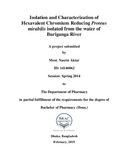Isolation and characterization of Hexavalent chromium reducing proteus mirabilis isolated from the water of Buriganga River

View/
Date
2019-02Publisher
BRAC UniversityAuthor
Aktar, Most. NasrinMetadata
Show full item recordAbstract
This study was conducted by considering the hazardous effects of hexavalent Chromium which is a highly carcinogenic, mutagenic and a teratogenic substance. In this study the sample was collected from Swari Ghat near the Buriganga River in Dhaka. After collecting the sample, it was isolated and purified. Then, Chromium reduction bioassay, antibiotic resistant profile, Minimum Inhibitory Concentration (MIC) and identification of the isolated sample were done. Di-phenyl Carbazide (DPCZ) and 3-(N-morpholino)propanesulfonic acid (MOPS) were used in the Chromium reduction bioassay. Also, in the bioassay, the experiment was done in three different temperature- 25˚C, 37˚C, 42˚C and three different pH 5.5, 7, and 8.5. In the result of bioassay it was observed that the strain had the best capacity to reduce the Chromium concentration at 37˚C and pH 8.5. Moreover, the strain had gone through the antibiotic resistant profile study to observe their resistance towards antibiotics. From this study it was found that cipropfloxacin (CIP5) and ceftriaxone (CRO30) had a strong effect on this strain whereas some other antibiotics such as penicillin (P10), vancomycin (VA30), trimethoprim (STX25), amoxycillin (AML10) did not have any effect on the strain. The Minimum Inhibitory Concentration method was used which showed that the strain could tolerate up to 16 mM of Chromium concentration in its surroundings and its MIC was 17 mM. Moreover, to identify the strain, 16s rDNA sequencing was done. A phylogenetic tree was made by using the sequence data and different software which showed that our isolated strain is Proteus mirabilis.
